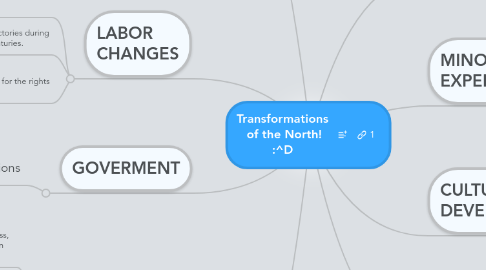
1. RESOURCES
1.1. People who were rich by finding oil or by other means were doing great. However, the middle class were having money troubles and needed help.
1.1.1. Human
1.1.1.1. The social gospel movement was created by protestant churches in the 20th century where they believed they should emulate Jesus and help the community, especially the needy.
1.1.1.1.1. Charities were created by non-government groups to help people in need in local areas.
1.1.1.1.2. One of the most important contributions to society was the creation of settlement houses.
1.1.2. Capital
1.1.2.1. Welfare was used to help the U.S citizens that were being payed low wages or jobless. People only needed to sign up to get it.
1.1.2.2. Food stamps were given to the citizens who needed food and special programs were created for people without jobs.
1.1.3. Natural
1.1.3.1. Edwin L. Drake went to Titusville, Pennsylvania to drill oil with a steam powered engine. Drake's success caused others to prospect and search for oil in that area, calling oil black gold.
1.1.3.1.1. Oil was, and still is, very valuable and whoever found a mass of it became very wealthy.
1.1.3.1.2. Oil well in Titusville
1.1.3.2. Chemists and geologists created a way to refine oil into kerosene.
1.1.3.2.1. Oil replaced whale blubber for heating houses and lighting lamps.
2. LABOR CHANGES
2.1. Because slavery was abolished, America lost a free labor force which caused the country to lose money.
2.2. Children worked at mills and factories during the late 19th and early 20th centuries.
2.2.1. Video Link: http://www.history.com/videos/the-fight-to-end-child-labor#the-fight-to-end-child-labor
2.3. Labor Unions were created to fight for the rights of working people.
2.3.1. They demanded the rights for safe and clean working conditions, less hours, and reasonable wages. They also were against child labor.
3. GOVERMENT
3.1. Actions
3.1.1. When immigrants come to America, the government nationalized them for citizenship.
3.1.2. To keep undesirable immigrants out, the government created the Language proficiency test and let them fail.
4. ADVANCES IN TECHNOLOGY
4.1. Henry Bessemer made the Bessemer process, which drastically cut the price of turning iron ore into steel.
4.1.1. Steel replaced a lot of iron because it was stronger. (e.g. Bigger multistory buildings, bridges, railroad tracks, etc.)
4.2. Elijah McCoy created a lubricating cup that was used to feed oil into machines while they were running, making them run smoother and faster.
4.3. More railroads caused more efficient transportation.In 1869, the first transcontinental railroad was built, stretching from Omaha, Nebraska to the Pacific Coast.
4.3.1. George Westinghouse created the first air brake, which increased locomotive safety. Granville T. Woods created a modified air brake based on Westinghouse's and also created a communication system for trains and stations to contact each other.
4.3.2. Double sets of tracks allowed two trains going opposite directions to pass each other, saving travel time.
4.3.3. Railroads caused unknown places to become towns and existing towns to major cities.
4.3.4. Railroad companies provided many people jobs.
4.3.5. Railroads helped many companies distribute their goods across the country.
4.3.5.1. Refrigerated freight cars were good for the meat- packing industry.
4.3.6. Video Link: http://www.history.com/topics/industrial-revolution/videos#transcontinental-railroad
4.4. Nikolaus A. Otto created the first gasoline-powered horseless carriage in 1876. In 1893, Charles and J. Frank Duryea created the first motorcar.
4.4.1. Many scientists and mechanics began making patents for this new way of transportation.
4.5. Orville and Wilbur Wright used combustion engines to create the first working airplanes. On December 17th, 1903, the Wright Brothers flew the first successful flight of 120 ft. in 12 seconds.
4.5.1. Many scientists and mechanics began making patents for this new way of transportation.
5. DEMOGRAPHIC CHANGES
5.1. more and more political machines start to pop up because hey create the illusion of economic growth. On the upper hand, this increase in jobs did speed up the building of infrastructure.
6. MINORITY EXPERIENCES
6.1. All immigrants were forced to pass through ellis Island and were put through rigorous examination such as a literacy test and educational exam.
6.1.1. immigrants not only had to pass these tests, but have high social connections in order to be able to take these tests, this is a way of making sure the nation receives the best of citizens
